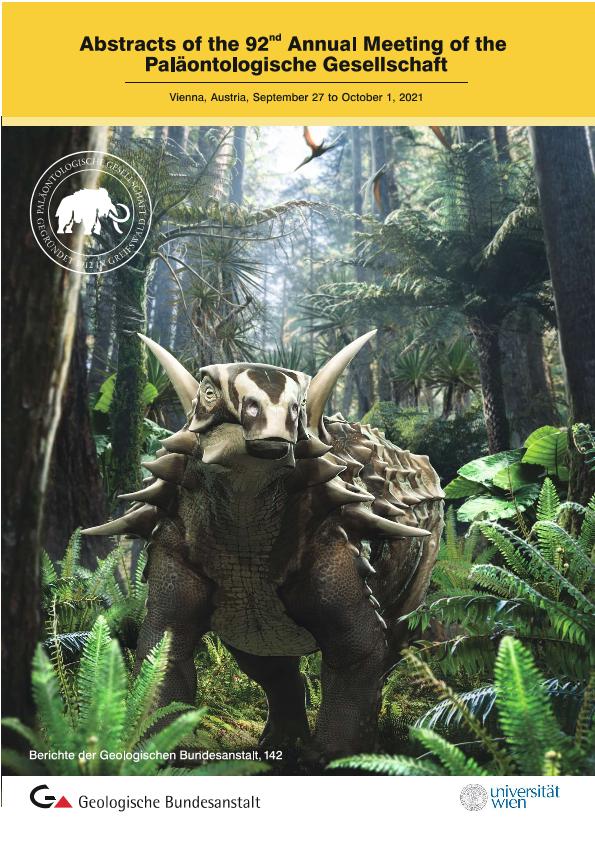Mostrar el registro sencillo del ítem
dc.contributor.author
Toscano, Agustina Gabriela

dc.contributor.author
Andrada, Alejandra Mariel

dc.contributor.author
Luci, Leticia

dc.contributor.author
Cataldo, Cecilia Soledad

dc.date.available
2022-10-12T17:37:24Z
dc.date.issued
2021
dc.identifier.citation
Fossiliferous concentrations - Unique bio-events in a second order lowstand wedge of the Lower Cretaceous (Neuquén Basin, Argentina); 92nd Annual Meeting of the Paläontologische Gesellschaft; Viena; Austria; 2021; 1-2
dc.identifier.issn
1017-8880
dc.identifier.uri
http://hdl.handle.net/11336/172748
dc.description.abstract
The Neuquén Basin (west-central Argentina) encompasses a nearly continuous Upper Triassic-lower Paleogene sedimentary record including marine and continental siliciclastics, carbonates and evaporites. Here, an early Valanginian marine succession representing a second order lowstand wedge (Mulichinco Formation) is studied at Cerro La Parva locality, in which several exceptional study cases are registered. The most remarkable of these can be found within the third order TST; it consists of 13-mthick, laterally extensive oyster mass occurrences (OMOs) of the genus Ceratostreon. They are up to 2,5 km wide and represent the maximum expression of OMOs recorded basinwide in equivalent stratigraphic levels, in localities up to 50 km apart from each other. These were interpreted as composite biogenic concentrations of intercalated bioherms and autobiostromes. The extraordinary proliferation of oysters represents a population burst bio-event, which according to geochemical analyses, was triggered by lowered salinity and high primary productivity. Below the OMOs, 20 m above the base of the third order LST, a lenticular monospecific nerineoid assemblage is recorded, representing a mixed-origin concentration (within-habitat wave-reworking of locally abundant shells). Up-section, above the OMOs in the third order HST several individuals of the glypheidean lobster species Atherfieldastacus rapax are preserved in incomplete reworked calcareous nodules in shales and shell beds. The abundance of lobsters in these two beds was interpreted as event-concentrations caused by storm reworking. Further up-section, soft-bottom dwelling serpulids are found encrusted by smaller serpulids and Ceratostreon. Oysters eventually covered the serpulids, forming masses that coalesced laterally to constitute at least three simple biogenic concentrations up to 30 cm-thick. Each of these fossil concentrations represent unique bio-events, most of which are not recorded elsewhere in the basin, reflecting particular conditions that are currently under research. Their integral study will allow us tounderstand the development of benthic communities along the second order LST.
dc.format
application/pdf
dc.language.iso
eng
dc.publisher
Geologische Bundesanstalt
dc.rights
info:eu-repo/semantics/openAccess
dc.rights.uri
https://creativecommons.org/licenses/by-nc-sa/2.5/ar/
dc.subject
Cerro La Parva
dc.subject
Mulichinco Formation
dc.subject
Benthic communities
dc.subject.classification
Paleontología

dc.subject.classification
Ciencias de la Tierra y relacionadas con el Medio Ambiente

dc.subject.classification
CIENCIAS NATURALES Y EXACTAS

dc.title
Fossiliferous concentrations - Unique bio-events in a second order lowstand wedge of the Lower Cretaceous (Neuquén Basin, Argentina)
dc.type
info:eu-repo/semantics/publishedVersion
dc.type
info:eu-repo/semantics/conferenceObject
dc.type
info:ar-repo/semantics/documento de conferencia
dc.date.updated
2022-09-29T11:05:06Z
dc.journal.pagination
1-2
dc.journal.pais
Austria

dc.journal.ciudad
Viena
dc.description.fil
Fil: Toscano, Agustina Gabriela. Consejo Nacional de Investigaciones Científicas y Técnicas. Oficina de Coordinación Administrativa Ciudad Universitaria. Instituto de Estudios Andinos "Don Pablo Groeber". Universidad de Buenos Aires. Facultad de Ciencias Exactas y Naturales. Instituto de Estudios Andinos "Don Pablo Groeber"; Argentina
dc.description.fil
Fil: Andrada, Alejandra Mariel. Consejo Nacional de Investigaciones Científicas y Técnicas. Oficina de Coordinación Administrativa Ciudad Universitaria. Instituto de Estudios Andinos "Don Pablo Groeber". Universidad de Buenos Aires. Facultad de Ciencias Exactas y Naturales. Instituto de Estudios Andinos "Don Pablo Groeber"; Argentina
dc.description.fil
Fil: Luci, Leticia. Consejo Nacional de Investigaciones Científicas y Técnicas. Oficina de Coordinación Administrativa Ciudad Universitaria. Instituto de Estudios Andinos "Don Pablo Groeber". Universidad de Buenos Aires. Facultad de Ciencias Exactas y Naturales. Instituto de Estudios Andinos "Don Pablo Groeber"; Argentina
dc.description.fil
Fil: Cataldo, Cecilia Soledad. Consejo Nacional de Investigaciones Científicas y Técnicas. Oficina de Coordinación Administrativa Ciudad Universitaria. Instituto de Estudios Andinos "Don Pablo Groeber". Universidad de Buenos Aires. Facultad de Ciencias Exactas y Naturales. Instituto de Estudios Andinos "Don Pablo Groeber"; Argentina
dc.relation.alternativeid
info:eu-repo/semantics/altIdentifier/url/https://backend.univie.ac.at/fileadmin/user_upload/k_palges2021/Berichte-142_Abstracts_PalGes_2021.pdf
dc.relation.alternativeid
info:eu-repo/semantics/altIdentifier/url/https://palges2021.univie.ac.at/en/
dc.conicet.rol
Autor

dc.conicet.rol
Autor

dc.conicet.rol
Autor

dc.conicet.rol
Autor

dc.coverage
Internacional
dc.type.subtype
Reunión
dc.description.nombreEvento
92nd Annual Meeting of the Paläontologische Gesellschaft
dc.date.evento
2021-09-27
dc.description.ciudadEvento
Viena
dc.description.paisEvento
Austria

dc.type.publicacion
Journal
dc.description.institucionOrganizadora
Universität Wien
dc.source.revista
Abstracts of the 92 Annual Meeting of the Paläontologische Gesellschaft
dc.date.eventoHasta
2021-10-01
dc.type
Reunión
Archivos asociados
